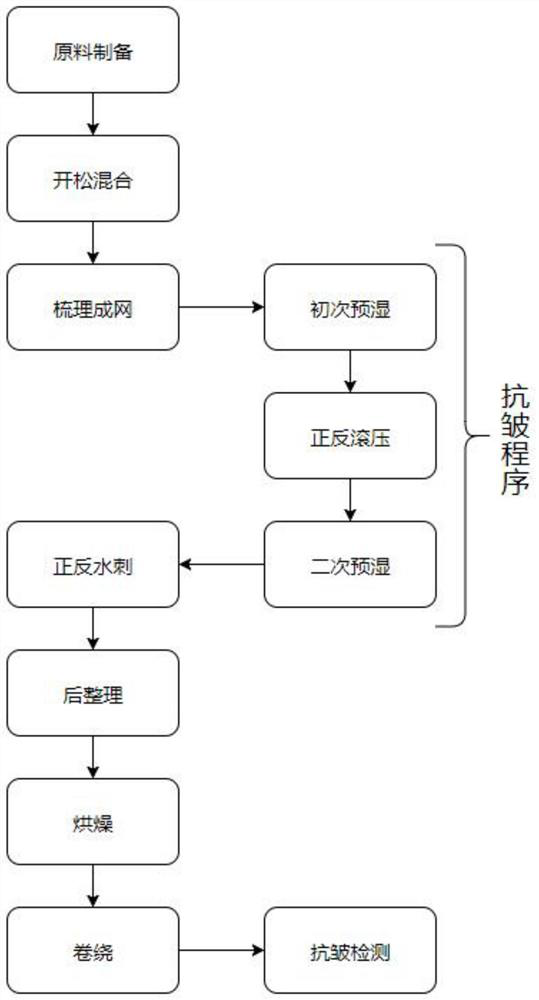Production process of environment-friendly colored non-woven fabric
A production process and non-woven technology, applied in the production process field of environmentally friendly colored non-woven fabrics, can solve the problems of unfavorable color non-woven fabric aesthetics, lack of anti-wrinkle and anti-folding processing technology, non-woven fabrics prone to creases and other problems
- Summary
- Abstract
- Description
- Claims
- Application Information
AI Technical Summary
Problems solved by technology
Method used
Image
Examples
Embodiment 1
[0030] see figure 1 , the present invention provides a technical solution: a production process of environmentally friendly colored non-woven fabrics, comprising the following steps:
[0031] Step 1, raw material preparation, prepared according to weight: 20 parts of polypropylene, 2 parts of bamboo fiber, 1 part of flax, 2 parts of coconut shell fiber, 1 part of kapok fiber, 5 parts of sisal hemp, 3 parts of sawdust, 1.5 parts of silk;
[0032] Step 2, opening and mixing, the polypropylene is divided into two equal parts, and the two equal parts polypropylene and the remaining raw materials in step 1 are mixed and opened respectively;
[0033] Step 3. Combing into a net, combing all raw materials except polypropylene into a base layer, and then carding two equal parts of polypropylene into a covering layer, and using an adhesive to adhere the two covering layers to the upper and lower surfaces of the base layer respectively , to form a fiber net; the covering layer is the ex...
Embodiment 2
[0049] see figure 1 , the present invention also provides a technical solution: a production process of environmentally friendly colored non-woven fabrics, comprising the following steps:
[0050] Step 1, raw material preparation, prepared according to weight: 25 parts of polypropylene, 3 parts of bamboo fiber, 3 parts of flax, 5 parts of coconut shell fiber, 2 parts of kapok fiber, 7 parts of sisal hemp, 4 parts of wood chips, and 3 parts of silk;
[0051] Step 2, opening and mixing, the polypropylene is divided into two equal parts, and the two equal parts polypropylene and the remaining raw materials in step 1 are mixed and opened respectively;
[0052] Step 3. Combing into a net, combing all raw materials except polypropylene into a base layer, and then carding two equal parts of polypropylene into a covering layer, and using an adhesive to adhere the two covering layers to the upper and lower surfaces of the base layer respectively , to form a fiber net; the covering lay...
Embodiment 3
[0068] see figure 1 , the present invention also provides a technical solution: a production process of environmentally friendly colored non-woven fabrics, comprising the following steps:
[0069] Step 1, raw material preparation, prepared according to weight: 22 parts of polypropylene, 2.5 parts of bamboo fiber, 1.5 parts of flax, 3 parts of coconut shell fiber, 1.6 parts of kapok fiber, 6.3 parts of sisal, 3.5 parts of wood chips, 2.2 parts of silk;
[0070] Step 2, opening and mixing, the polypropylene is divided into two equal parts, and the two equal parts polypropylene and the remaining raw materials in step 1 are mixed and opened respectively;
[0071] Step 3. Combing into a net, combing all raw materials except polypropylene into a base layer, and then carding two equal parts of polypropylene into a covering layer, and using an adhesive to adhere the two covering layers to the upper and lower surfaces of the base layer respectively , to form a fiber net; the covering ...
PUM
 Login to View More
Login to View More Abstract
Description
Claims
Application Information
 Login to View More
Login to View More - R&D
- Intellectual Property
- Life Sciences
- Materials
- Tech Scout
- Unparalleled Data Quality
- Higher Quality Content
- 60% Fewer Hallucinations
Browse by: Latest US Patents, China's latest patents, Technical Efficacy Thesaurus, Application Domain, Technology Topic, Popular Technical Reports.
© 2025 PatSnap. All rights reserved.Legal|Privacy policy|Modern Slavery Act Transparency Statement|Sitemap|About US| Contact US: help@patsnap.com

